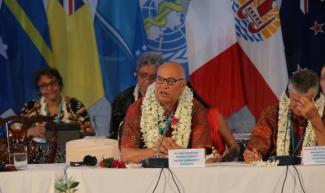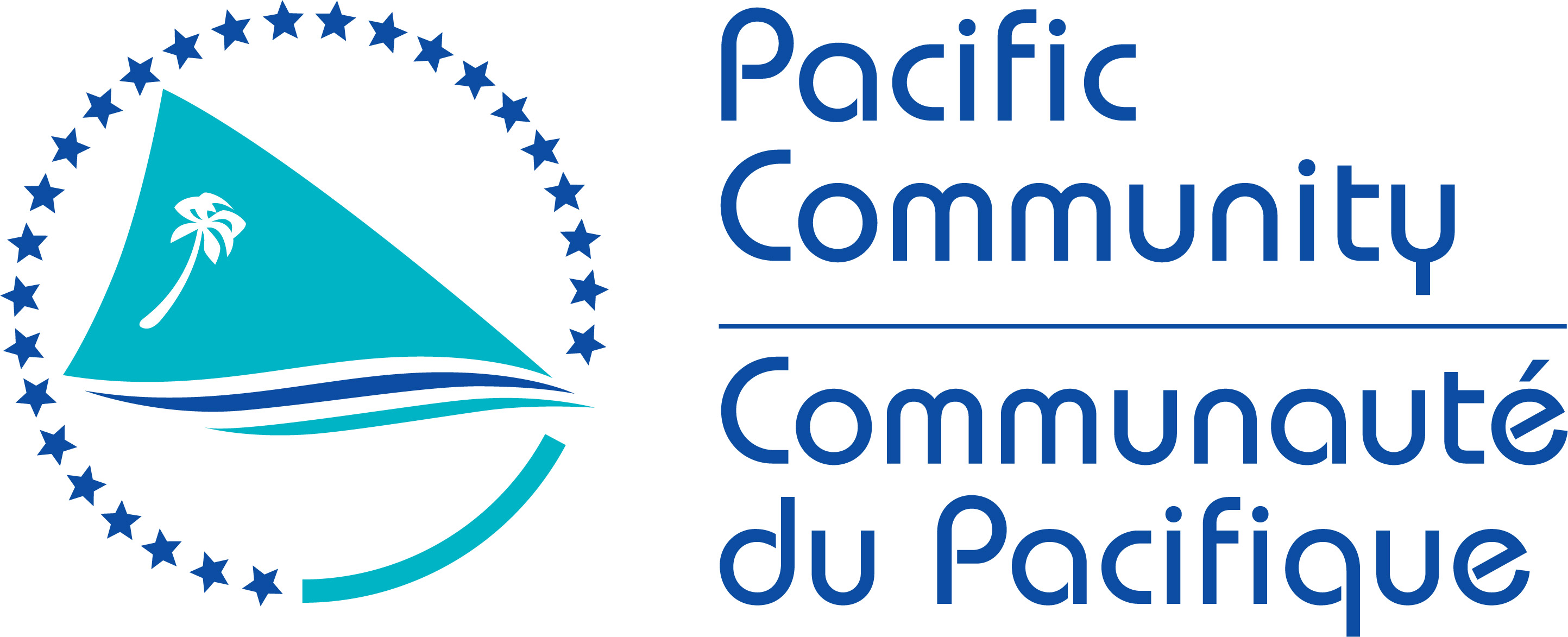
check against delivery
13th Pacific Health Ministers Meeting
Remarks by Colin Tukuitonga, Director-General of the Pacific Community (SPC)
07 to 09 August 2019 - Papeete, French Polynesia
Ia orana, bonjour and Pacific greetings
I would like pay my respects to the traditional landowners of this land on which this meeting is being held.
I would like to acknowledge the very warm welcome by President Édouard Fritch extended to us this morning
Minister of Health, French Polynesia, Dr Jacques Raynal who with his team are hosting the 13th Pacificic Health Ministers Meeting.
Honourable Ministers of Health and heads of delegations from across the Pacific. I would like to especially welcome the minister from Australia, Hon Greg Hunt and associate minister from NZ, Hon Jenny Salesa to the first PHMM with Australia and NZ being full members.
Heads of Health,
Dr Tedros, WHO Director-General, who will be arriving later today
Dr Takeshi Kasai, Regional Director for the Western Pacific Region,
UN agency representatives, development partners
Ladies and gentlemen.
From the outset, I wish to extend my appreciation to the Government of French Polynesia and the Ministry of Health for the hospitality extended to us all since our arrival in Pape’ete. Mauruuru et merci beaucoup.
In 2015 at the 20th anniversary of this meeting, Pacific health ministers including some of you recommitted to the Healthy Islands vision as the overarching roadmap for the Pacific’s health sector. The meeting agreed that it was still relevant and it should continue to be pursue with measurable milestones to monitor its progress with the ultimate objective of ensuring the Pacific is a better place.
Despite the progress health in the Pacific has made, much needs to be done still. The Pacific today is a different place to what it was 25 years ago and our region faces a multitude of challenges:
- Climate change and its impact including the frequency of natural disasters have increased with significant impact on our people and fragile economies.
- The NCD crisis continues to unfold across the Pacific and is compounded by the burden of communicable diseases including continuing outbreaks of dengue, measles, typhoid and the emergence of diseases such as Zika and Chikungunya.
- Health systems in Pacific countries are struggling to cope with the demand its populations are placing on them. Static or decreasing government funding is common and there is increasing reliance on development partner funding for operational costs.
- The exodus of skilled health care professionals continues; under resourced health information systems is the norm, medical consumable and drug procurement challenges and the high cost of maintenance and repair of medical equipment and health infrastructure place added pressure on limited resources.
We are gathered here this week in this splendid location (which I trust will not be too much of a distraction) to discuss your priorities and agenda.
Over the past few years, we have seen an increasing desire from countries to take leadership and ownership of the work to address health in the region. This has been helped by strong leadership from ministers and heads of health as well as structural changes including the Pacific Heads of Health Meeting for CEOs and the Director of Clinical Services Meeting. I am pleased to note that this year we will start the first Pacific Heads of Nursing Meeting and from next year, the Directors of Public Health Meeting. Strengthening the regional health architecture is important and it looks like we have strong governance mechanisms to ensure our efforts are aligned and maximised. As an aside, in my role, I am exposed to many different disciplines and the health regional architecture is something that you can all be proud of.
NCDs remain a major health and development challenge in the Pacific and with climate change make us the two most important risks to the Pacific recognising its national and regional development potentials.
You are familiar with the numbers and I will not go through these again although it is important to remember that many of these NCD related deaths are premature and are preventable. It will be difficult to meet any Pacific islander who has not been impacted in some way.
To your credit, the Pacific has not shied away with putting in place the necessary processes and systems to address NCDs. We developed the first regional multi-sectoral roadmap endorsed by the Joint Finance and Health Ministers meeting in 2014. This was followed in 2017 by the endorsement of the Pacific Monitoring Alliance for NCD Action (MANA), the first regional accountability framework. The Roadmap and MANA have allowed countries and partners to be on the same page on what is needed to drive NCD action.
At this meeting, you will be discussing additional initiatives including the Pacific Ending Childhood Obesity, the Pacific Legislative Framework as well as Cancer.
It is often easy to be disheartened when we do not see positive changes to NCD rates. We are confident that with your leadership and appropriate systems in place, we are confident that we will see the fruits of our labour in due course.
It would be fair to say that any health system’s ability to deliver services to its population depends largely on a workforce that has the right numbers, employed at the right location, with the right competencies and skill mix.
In reviewing the Outcomes from all the last 13 Pacific Health Ministers Meetings, the only item that has remained constant is human resources for health. This is a clear indication of the ongoing priority Pacific Ministers over the years have afforded this key health system building block. Perhaps it is also a reflection that perhaps we are not meeting the expectations countries have to address this critical issue.
In most Pacific Island Countries over 50% of recurrent budgets are consumed by staff costs, thus it makes sense investments in workforce development and subsequent management once employed is scrutinised to ensure value add and return on investment.
Honourable Ministers will be invited to discuss a paper on preliminary results of a survey of medical workforce in selected Pacific Island countries. While we have reason to be proud of the progress made with regard to medical workforce development, further gains are required to ensure Pacific island countries meet WHO’s Surgeon, Anaesthetist and Obstetrician (SAO) benchmarks and other regional and national workforce indicators.
This will be linked to the Safe and Affordable Surgery and Anaesthesia which the Pacific has been leading and resulted in a very successful side event at the WHA earlier this year sponsored by Fiji, Palau, Tonga and a couple of our fellow SIDS from the Caribbean.
Early results of the survey were discussed at the 2019 Pacific Heads of Health meeting where the secretariat was given clear instructions the survey be expanded to cover all health care cadres. In my view, this is an important piece of work and encourage development partners to support this undertaking and to address the pertinent findings.
In 2017, SPC became part of the Pacific Clinical Services Programme funded by the Australian government has been hosted by. Our team works together with the Fiji National University and the Royal Australasian College of Surgery to strengthen of specialised clinical services.
The 2019 Pacific Heads of Health meeting approved the expansion of the Directors of Clinical Services membership from 14 to include all 22 PICT’s in 2020. The expansion means the programme will need to attract additional resources to serve the increased membership as well and ensuring current commitments are fulfilled.
The Program continues to support Pacific Clinical Organisations including but not limited to Anaesthesia, Mental Health, Emergency Medicine, Reproductive Health, Internal Medicine and Operating Room Nurses.
In recommitting to the Healthy Island Vision, the 2015 Pacific Health Minister Meeting instructed the secretariat to develop a mechanism to track progress, (or lack thereof) across the 22 Pacific island countries and territories. Hence the Healthy Islands Monitoring Framework’s development. The first report was presented at the 2017 meeting in the Cook Islands and the second report will be tabled and discussed this week.
This will be my last PHMM after having served my six-year term as your Director General of SPC. It has been a very rewarding time and I would like to thank you all sincerely for your support to SPC and me during this time. Similarly, to development partners including Australia, NZ, France and USA who have been supporting our Public Health team.
If I can just offer some thoughts that might perhaps make the work better:
- We need a very cohesive mechanism to adequately address climate change and health. I am pleased to inform you that SPC has recently been accredited to the Green Climate Fund. We are discussing with some of the countries to identify suitable intervention and support. The GCF is keen to have projects in health as increased resilience of health and wellbeing is one of the key adaptation result areas of GCF.
- Partner collaborations need to continue to be strengthened in order for us to serve the countries better. There is more than enough work for all the partners and through stronger collaboration and better role delineation, we will be better able to serve the countries. I am pleased that later this week, one of my last duties will be a sign a revised MOU with WHO to re-energise the working relationship between the two organisations.
- We need more Pacific people in our regional and international organisations. We often hear that organisations shy away from recruiting Pacific people because they do not want to take away people from the countries. The reality is, some good people choose to stay and some good people choose to leave. We might as well benefit the countries by getting some of these good people to help us serve the countries better. I can say from our own organisation, that we proud to say that we are a better organisation in having Pacific professionals to work with our non-Pacific professionals. After all regional and international organisations working in Health should all be seen as extensions of the human resources available in country.
- It may be the right time to carry out a review of the PHMM, its impact and how it can be better. The PHMM has been at the forefront of advocating for accountability including the Healthy Islands Monitoring Framework and the Pacific MANA for NCDs. A review (and response to the findings) of this institution that has been around since 1995 will in my view make it a stronger going forward.
- Finally, it would be remiss of me to finish my remarks without acknowledging your confidence in me and for NZ nominating me as a candidate for the role of WHO RD for the Western. I am honoured and have no regrets in having gone through the process. We will continue to offer Dr Kasai all our support and wish him all the very best.
I wish you a productive meeting and reiterate SPC remains committed to continuing to support your countries.
Mauruuru, merci beaucoup and thank you
